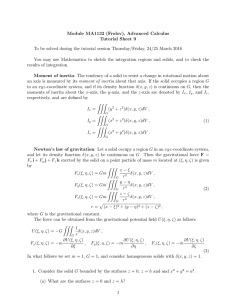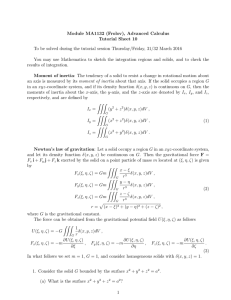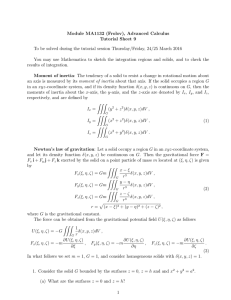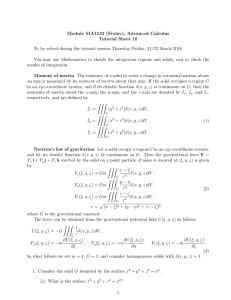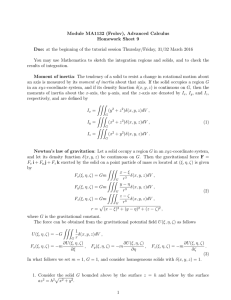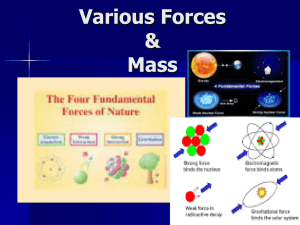Module MA1132 (Frolov), Advanced Calculus Homework Sheet 9
advertisement
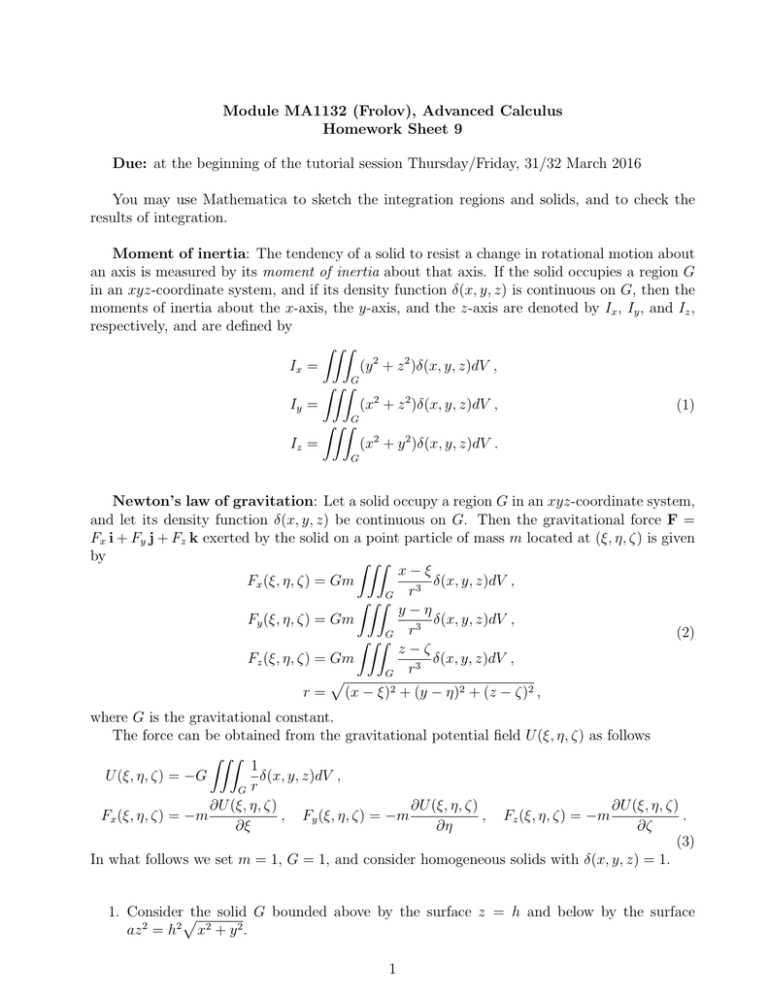
Module MA1132 (Frolov), Advanced Calculus Homework Sheet 9 Due: at the beginning of the tutorial session Thursday/Friday, 31/32 March 2016 You may use Mathematica to sketch the integration regions and solids, and to check the results of integration. Moment of inertia: The tendency of a solid to resist a change in rotational motion about an axis is measured by its moment of inertia about that axis. If the solid occupies a region G in an xyz-coordinate system, and if its density function δ(x, y, z) is continuous on G, then the moments of inertia about the x-axis, the y-axis, and the z-axis are denoted by Ix , Iy , and Iz , respectively, and are defined by ZZZ (y 2 + z 2 )δ(x, y, z)dV , Ix = Z Z ZG (x2 + z 2 )δ(x, y, z)dV , Iy = (1) G ZZZ Iz = (x2 + y 2 )δ(x, y, z)dV . G Newton’s law of gravitation: Let a solid occupy a region G in an xyz-coordinate system, and let its density function δ(x, y, z) be continuous on G. Then the gravitational force F = Fx i + Fy j + Fz k exerted by the solid on a point particle of mass m located at (ξ, η, ζ) is given by ZZZ x−ξ δ(x, y, z)dV , Fx (ξ, η, ζ) = Gm r3 G ZZZ y−η Fy (ξ, η, ζ) = Gm δ(x, y, z)dV , r3 (2) G ZZZ z−ζ Fz (ξ, η, ζ) = Gm δ(x, y, z)dV , 3 G r p r = (x − ξ)2 + (y − η)2 + (z − ζ)2 , where G is the gravitational constant. The force can be obtained from the gravitational potential field U (ξ, η, ζ) as follows ZZZ 1 U (ξ, η, ζ) = −G δ(x, y, z)dV , G r ∂U (ξ, η, ζ) ∂U (ξ, η, ζ) ∂U (ξ, η, ζ) Fx (ξ, η, ζ) = −m , Fy (ξ, η, ζ) = −m , Fz (ξ, η, ζ) = −m . ∂ξ ∂η ∂ζ (3) In what follows we set m = 1, G = 1, and consider homogeneous solids with δ(x, y, z) = 1. 1. Considerpthe solid G bounded above by the surface z = h and below by the surface az 2 = h2 x2 + y 2 . 1 (a) (b) (c) (d) (e) (f) (g) (h) What is the surface z = h? p Describe the surface az 2 = h2 x2 + y 2 Sketch the solid G. Sketch the projection of the solid G onto the xy-plane. Find the volume V of the solid G. Find the centroid of the solid G. Find the moments of inertia of the solid G. Find the gravitational force exerted on a point particle by the solid G if the point particle is located at the origin (0, 0, 0). Find its limit as a → ∞ with h kept fixed, and its limit as h → ∞ with a kept fixed. Show the details of your work. 2. Consider the solid G bounded by the surfaces z = 0, z = h and x2 + y 2 = a2 . (a) What is the solid? (b) Find the gravitational force exerted on a point particle by the solid G if the point particle is located on the z-axis at (0, 0, ζ) (ζ can be any real number) (c) Plot its graph and the graph of ∂Fz /∂ζ for a = 1, h = 2 (use Mathematica). (d) Find the limit of Fz as a → ∞ with h and ζ kept fixed. (e) Find the limit of Fz as h → ∞ with a and ζ kept fixed. p 3. Consider the solid G bounded below by the surface z = rα , α > 0, r = x2 + y 2 and above by the plane z = 1. Note that the surface z = r is a cone, and z = r2 is a paraboloid. (a) Sketch the surface z = rα for α = 1/2, α = 1, α = 2, and the projection of the solid G onto the xy-plane. (b) Find the volume V of the solid G, and its limit as α → ∞. (c) Find the centroid of the solid G, and its limit as α → ∞. (d) Find the moments of inertia of the solid G, and its limit as α → ∞. (e) Use Mathematica to find the gravitational force exerted on a point particle by the solid G if the point particle is located at the origin (0, 0, 0). (f) Use Mathematica to plot Fz as a function of α, and find its limit as α → ∞. (g) Explain the limiting values obtained in (b), (c), (d), (f). Show the details of your work. Bonus questions (each bonus question is worth extra 25 marks) 1. Consider the solid G bounded above by the surface z = h and and below by the surface a2 z 2 = h2 (x2 + y 2 ). Plot the solid for a = 1, h = 2. Find the gravitational force exerted on a point particle by the solid G if the point particle is located on the z-axis at (0, 0, ζ) (ζ can be any real number), and plot its graph and the graph of ∂Fz /∂ζ for a = 1, h = 2 (use Mathematica). 2
